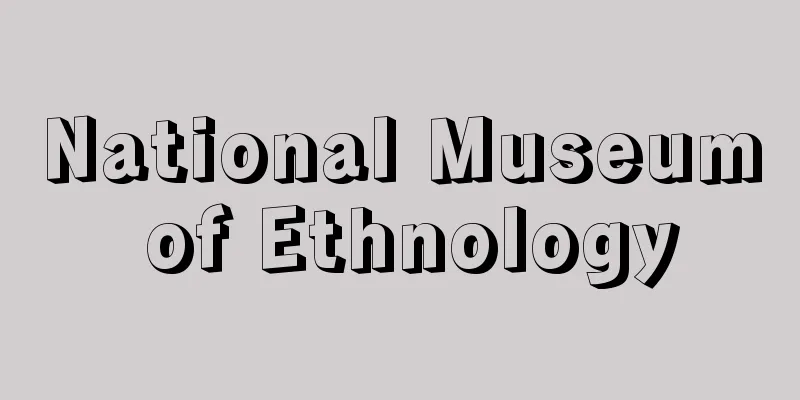National Museum of Ethnology

|
It is a research institute that constitutes the Inter-University Research Institute Corporation National Institutes for the Humanities, which was established under the National University Corporation Act. Located within Expo '70 Commemorative Park in Suita City, Osaka Prefecture, it is a research and education center for cultural anthropology and ethnology. It was established in 1974 (Showa 49) and opened in 1977. It was incorporated in 2004 (Heisei 16) and became a constituent institute of the National Institutes for the Humanities. Its English name is the National Museum of Ethnology, and it is abbreviated as Minpaku. It is often written as "Minpaku." The first director was Umesao Tadao. The National Museum of Ethnology has a variety of functions, including a research institute with museum functions, an information center that stores and publishes materials in a database, and a civic educational institution that returns cutting-edge research results to society through lectures, film screenings, and workshops.It also has a Graduate University for Advanced Studies, with two majors, Area Culture Studies and Comparative Culture Studies, established under the Graduate School of Cultural Studies, and is working to train the next generation of experts. The museum exhibits are made up of regional and cross-cultural exhibits. The regional exhibits are divided into Oceania, America, Europe, Africa and various parts of Asia, including Japan, and are structured to give visitors an insight into the lives of people in each region, focusing on everyday items such as food, clothing and shelter. The cross-cultural exhibits focus on specific genres, such as music and language, and provide an overview of the world's ethnic cultures. In the main building's special exhibition hall and special exhibition hall, exhibitions are held for a limited time on individual themes such as contemporary issues and cutting-edge research results. Unique special exhibitions have been held in the past, such as "Multi-ethnic Japan - The lives of foreigners in Japan" (2004) and "Looms and Textiles of the World - Try and Weave! Discover the Secrets of Weaving" (2012). In addition, a video archive called the "Videotheque" allows visitors to choose from hundreds of video programs, allowing them to see how the exhibits are actually used. [Tomoko Ochiai May 21, 2018] [References] | | | | |This is a research museum that conducts surveys and research on ethnology and cultural anthropology, and collects and displays materials based on the results of the surveys and research. The building was designed by Kisho Kurokawa and opened in 1977 (Showa 52). It has four floors above ground, and the permanent exhibition space on the second floor displays materials related to the societies and cultures of the world's ethnic groups, which are arranged so that they can be compared with Japanese culture. Suita City, Osaka Prefecture ©Shogakukan "> National Museum of Ethnology Source: Shogakukan Encyclopedia Nipponica About Encyclopedia Nipponica Information | Legend |
|
国立大学法人法に基づいて設置された、大学共同利用機関法人人間文化研究機構を構成する研究機関。大阪府吹田(すいた)市の万国博記念公園内に所在する、文化人類学・民族学に関する研究・教育拠点である。1974年(昭和49)に発足し、1977年に開館。2004年(平成16)に法人化され、人間文化研究機構の構成機関となった。英語名はNational Museum of Ethnology、略称は民博。「みんぱく」と表記されることが多い。初代館長は梅棹忠夫(うめさおただお)。 国立民族学博物館は、博物館機能を有する研究所、資料をデータベース化し蓄積・公開する情報センター、最先端の研究成果を講演会・映画会・ワークショップを通じて社会に還元する市民教育機関など、多様な機能をもつ。また、総合研究大学院大学をもち、文化科学研究科のもと、地域文化学専攻と比較文化学専攻の2専攻が設置され、次世代の専門家の育成に努めている。 博物館展示は地域展示と通文化展示から構成される。地域展示はオセアニア、アメリカ、ヨーロッパ、アフリカ、それに日本を含むアジア各地域に分け、衣食住の生活用品を中心に各地域の人々の暮らしがわかる構成になっている。通文化展示では音楽と言語という特定のジャンルを取り上げて、世界の民族文化を通覧する。本館企画展示場や特別展示館では、期間を限って、現代的な問題や最先端の研究成果など個別のテーマを取り上げた展示を行う。これまで「多みんぞくニホン─在日外国人のくらし─」(2004)、「世界の織機と織物─織って!みて!織りのカラクリ大発見」(2012)など、ユニークな企画展・特別展が行われてきた。 また、「ビデオテーク」とよばれる映像アーカイブでは数百本の映像番組を自分で選択して視聴することが可能。その映像を通じて、展示物が実際に用いられているようすを確認することができる。 [落合知子 2018年5月21日] [参照項目] | | | | | |民族学・文化人類学に関する調査・研究を行うとともに、その成果に基づいて資料の収集・公開などを行う研究博物館。建物は黒川紀章の設計で、1977年(昭和52)に開館した。地上4階建てで、2階の常設展示場には、世界の民族の社会・文化に関する資料が展示され、日本文化との比較ができるように構成されている。大阪府吹田市©Shogakukan"> 国立民族学博物館 出典 小学館 日本大百科全書(ニッポニカ)日本大百科全書(ニッポニカ)について 情報 | 凡例 |
>>: National Popular Theatre (TNP)
Recommend
Calix sect - Calix is
...Sigismund, receiving a bull from Pope Martin V...
Great Ape
…Since 1899, he conducted research on many animal...
Meguro Fudo
A Tendai sect temple located in Shimomeguro, Megu...
Arakan [State] (English spelling)
One of the seven states in the Union of Myanmar. C...
Battery - denchi (English spelling) battery
It can be defined as a power generating device th...
Blackfin barracuda
A marine fish belonging to the order Perciformes,...
Prefecture Hill - Agatazaka
...With the inns of Narai to the north and Yabuha...
Reflux - Gyakuru
〘Noun〙 Buddhist term. ① To go against the flow of ...
Kyrillos Loukaris
1572‐1638 Patriarch of Constantinople. He attempte...
Ant-grosbeak - Ant-grosbeak
A delicate perennial herb of the Trillium family t...
Bisque
…Onion soup gratin and mussel soup are typical. (...
Yuzo Saeki
Western-style painter. Born on April 28, 1898, in...
Reciprocating rolling mill
… When electric motors came into use around 1900,...
Giki
(Noun) ("Gi" refers to the special privi...
Vologda (English spelling)
Vologda is the capital of Vologda Oblast in northw...









